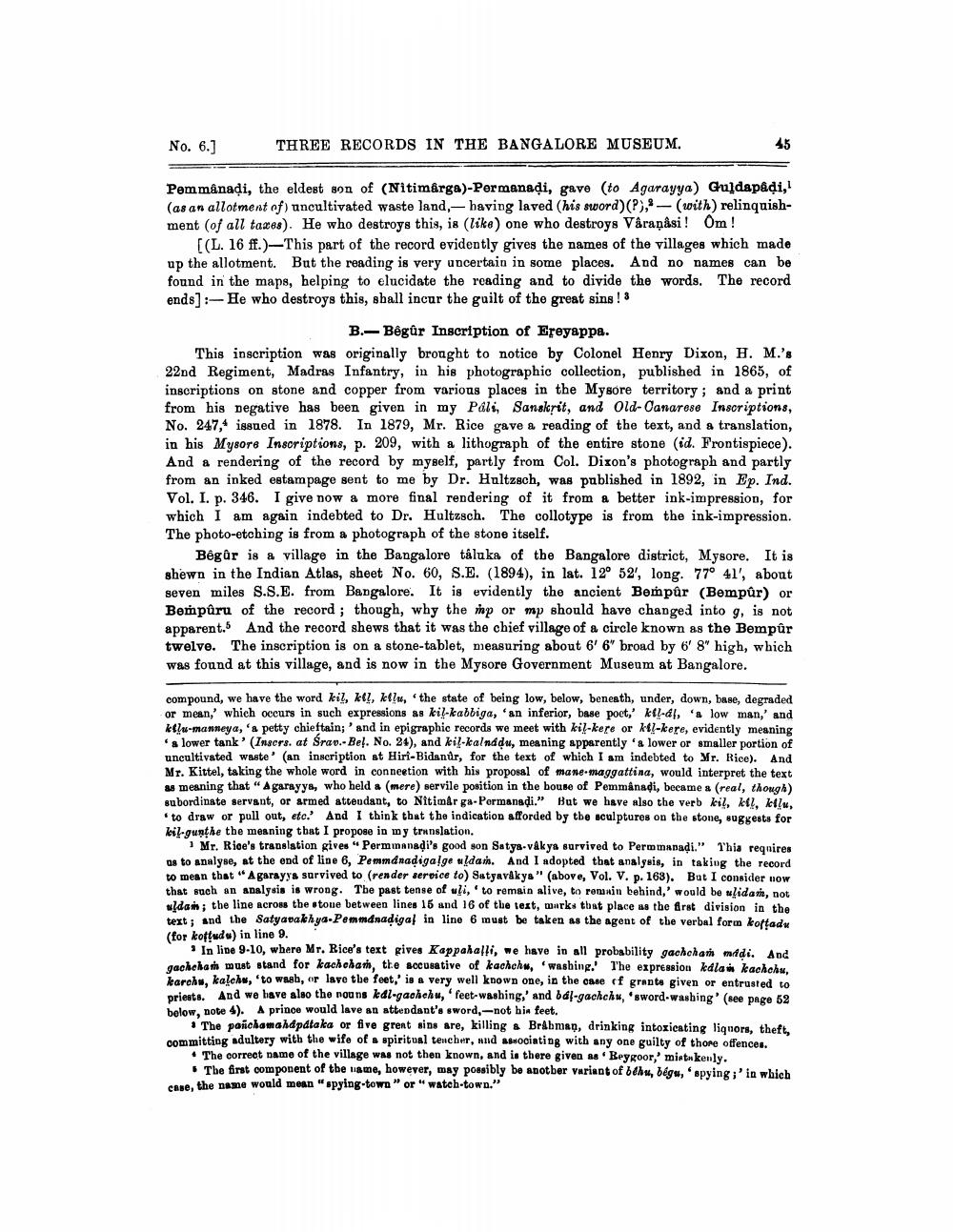________________
No. 6.]
THREE RECORDS IN THE BANGALORE MUSEUM
Pemmånadi, the eldest son of (Nitimärga)-Permanadi, gave (to Agarayya) Guldapadi, (as an allotment of) uncultivated waste land, - having laved (his sword)(P), (with) relinquishment (of all taxes). He who destroys this, is (like) one who destroys Våraņåsi! Om !
[(L. 16 ff.)-This part of the record evidently gives the names of the villages which made up the allotment. But the reading is very uncertain in some places. And no names can be found in the maps, helping to elucidate the reading and to divide the words. The record ends] : He who destroys this, shall incur the guilt of the great sins! 8
B.-Bégûr Inscription of Ereyappa. This inscription was originally brought to notice by Colonel Henry Dixon, H. M.'s 22nd Regiment, Madras Infantry, in his photographic collection, published in 1865, of inscriptions on stone and copper from various places in the Mysore territory; and a print from his negative has been given in my Pali, Sanskrit, and Old-Canarese Inscriptions, No. 247,4 issued in 1878. In 1879, Mr. Rice gave a reading of the text, and a translation, in his Mysore Inscriptions, p. 209, with a lithograph of the entire stone (id. Frontispiece). And a rendering of the record by myself, partly from Col. Dixon's photograph and partly from an inked estampage sent to me by Dr. Hultzsch, was published in 1892, in Ep. Ind. Vol. I. p. 346. I give now a more final rendering of it from a better ink-impression, for which I am again indebted to Dr. Hultzsch. The collotype is from the ink-impression. The photo-etching is from a photograph of the stone itself.
Bêgûr is a village in the Bangalore táluka of the Bangalore district, Mysore. It is shewn in the Indian Atlas, sheet No. 60, S.E. (1894), in lat. 12° 52', long. 77° 41', about seven miles S.S.E. from Bangalore. It is evidently the ancient Bempur (Bempûr) or Bempuru of the record ; though, why the mp or mp should have changed into g, is not apparent. And the record shews that it was the chief village of a circle known as the Bempûr twelve. The inscription is on a stone-tablet, measuring about 6' 6' broad by 6' 8" high, which was found at this village, and is now in the Mysore Government Museum at Bangalore.
compound, we have the word keil, kl}, kt!u, the state of being low, below, beneath, under, down, base, degraded or mean, which occurs in such expressions as kil-kabbiga, "an inferior, base poet,' kil-dl'low man,' and kelu-manneya, 'a petty chieftain;' and in epigraphic records we meet with kil-kere or M?-kere, evidently meaning 's lower tank' (Ingers. at Srav.. Bel. No. 24), and kil-kalnadu, meaning apparently 'a lower or smaller portion of uncultivated waste (an inscription at Hiri-Bidanúr, for the text of which I am indebted to Mr. Rice). And Mr. Kittel, taking the whole word in conneetion with his proposal of man- maggattina, would interpret the text as meaning that " agarayys, who held a (mere) servile position in the bouse of Pemmånadi, became a (real, though) subordinate servant, or armed attendant, to Nitimar ga-Permanadi." But we have also the verb kil, ky, kt!,
to draw or pull out, etc.' And I think that the indication afforded by the sculptures on the stone, suggests for lil.gunthe the meaning that I propose in my trunslation,
Mr. Rioe's translation gives "Perminanadi's good son Satya-vakya survived to Perm manadi." This reqnires us to analyse, at the end of line 6, Pemmdnadigalge aldan. And I adopted that analysis, in taking the record to mean that "Agarayys survived to (render service to) Satyavákys" (above, Vol. V. p. 168). But I consider now that such an analysis is wrong. The past tense of uli,' to remain alive, to remain behind,' would be mfidan, not wldan; the line across the stoue between lines 15 and 16 of the text, marks that place as the first division in the text; and the Satyavakhya.Pemmdnadigal in line 6 must be taken as the agent of the verbal form kottadu (for kortuds) in line 9.
In line 9.10, where Mr. Rice's text gives Kappahalli, we have in all probability gachchan midi. And gachchath must stand for kachchan, the accusative of kachchu, washing.' The expression kalau kachchu. searchy, kalohu, 'to wasb, ar lave the feet,' is a very well known one, in the case of grants given or entrusted to prieste. And we have also the nouns kdl.gachchu, 'feet-washing,' and bdl-gachchu, sword.washing' (see page 52 below, note 4). A prince would lave an attendant's sword, not his feet.
The paiohamahdpdtaka or five grent sins are, killing & Brabman, drinking intoxicating liquors, theft, committing adultery with the wife of a spiritual tencher, and associating with any one guilty of thore offences.
The correct name of the village was not then known, and is there given as. Beygoor, mistakenly.
The first component of the name, however, may possibly be anotber variant of thu, begu, spyingi' in which case, the name would mean "spying-town" or "watch-town."




